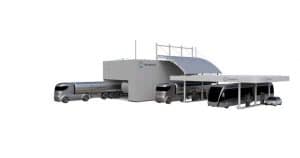Gaseous or liquid hydrogen? It’s a dilemma facing everyone involved in the refueling of heavy-duty vehicles. It makes no difference to the power system whether the fuel is a gas or a liquid as the fuel cells can process the hydrogen regardless. In infrastructure terms, however, it’s another matter. The consensus among experts is that it’s not economically viable for fuel station operators to support every available technology in the long run. One alternative is cryogas, which is produced by cooling pressurized gas to extremely low temperatures or by directly compressing liquid hydrogen. Work is currently underway to deliver cryogas tank systems that will give a range of around 620 miles (1,000 kilometers), the CryoTRUCK project and the Salzburger Aluminium Group initiative being prime examples.
The most popular way to store hydrogen in vehicles is in the form of compressed gaseous hydrogen, otherwise known as CGH2, at 700 bar. Despite this high pressure level, at ambient temperature it’s still not enough to compress the gas to a density that will allow 80 kilograms of hydrogen to be stored within the installation space available in today’s long-haul trucks, says Tobias Brunner. According to the director of startup company Cryomotive, the high storage pressure also leads to high costs for the carbon-fiber tank reinforcement. Added to this is the considerable amount of energy required to pressurize the hydrogen and precool it during refueling.
Another option for commercial vehicles is the storage of liquid hydrogen, LH2 for short, in vacuum-insulated low-pressure vessels. These have the advantage of allowing a high physical density which is inherent in the liquefaction of hydrogen. On the negative side, a substantial amount of energy is needed during liquid hydrogen production in order to cool hydrogen gas to ultra-low temperatures of around -250 °C. The risk of evaporation and the associated hydrogen losses caused by warming are also additional drawbacks. In order to prevent hydrogen boil-off, a high level of insulation is crucial.
This means that the two vehicle storage techniques that are available today for hydrogen, namely compressed gas or liquid hydrogen, are subject to a number of technical challenges. Enter cryogas. A cryogenic gas at pressures of up to 400 bar and with temperatures ranging between -240 °C to -100 °C, this alternative means of hydrogen storage can be arrived at in one of two ways: through the cooling of compressed gas to ultra-low temperatures or through the direct compression of liquid hydrogen. “Cryogas marries the benefits of gaseous and liquid hydrogen while also avoiding most of the disadvantages,” says Cryomotive boss Brunner.[…]
… Read this article to the end in the latest H2-International
Author: Michael Nallinger

























I agree. The most applicable solution for bulk gas transportation is ultra-low tempetaure gas in Type 3 composite cylinder. This author has a recently issued patent.
Gopala Krishna Vinjamuri
Great, need to do this in the US too! Where is my H2 mag? GEE
The best way of storing H2 safely and without technical problems, is to bind it to another metal, e.g. like in NaBH4. I cannot understand why these kinds of techniques apparently have not been pursued further.